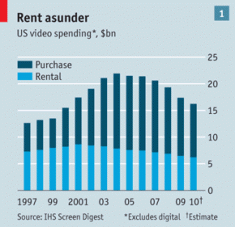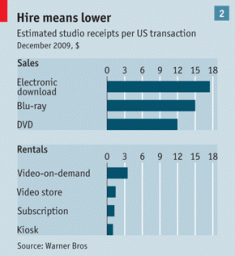Feels like things are moving even quicker than usual in the motion picture business right now. More than once since I started this post I’ve had to rework something I’ve just written in response to news breaking somewhere in one of my feeds.
With so much great reporting and commentary already out there (much of which I’ve linked out to) it would be pointless, not to mention futile, to try and offer a remotely comprehensive account of the past, present and future of film distribution.
Instead I’ve tried to draw together the latest developments to create a coherent snapshot of where we find ourselves: in a period of massive upheaval in the home entertainment market, on the cusp of a paradigm shift in terms of how we discover and watch movies.
I’ve rounded it off with my own take on where things could be heading, and how best the industry can adapt itself to go on maximising returns across the life-cycle of any given film or franchise.
The trigger for me to start work on this post was reading that Warner Bros., building on the presumed success of the US-only pilot rental of The Dark Knight via a Facebook app, is now extending this to encompass five more titles spanning different genres and demographics.
At the time of writing almost 100,000 people had added the Watch The Dark Knight Facebook app since its launch. We don’t know how many of them paid 30 Facebook Credits (that’s 3 Earth dollars to you and I) to rent the film, but it appears to have been enough for Warner Bros. to choose to experiment further.
Since then other signs have appeared that the studios are ready to embrace social media as a platform for rental and on-demand movies. News broke a few days ago that YouTube is now ‘weeks not months’ from launching a ramped-up movie rental service, offering content from Sony, Warner Bros., Universal and, as of twenty-four hours later, Fox. YouTube has been offering feature length films for some time now but the move to offering premium releases from four of the ‘big six’ studios (Disney and Paramount have not, as yet, signed up) looks like a significant moment in the evolution of a platform with its origins in user-generated content.
Even as recently as last week TechCrunch broke the news that Euro-centric music streaming service Spotify is making headway with the studios, negotiating worldwide rights to show movies within weeks of theatrical release, on similar terms to those used by hotel chains for premium in-room movies. (Spotify CEO Daniel Ek popped up on Twitter shortly thereafter to categorically deny this but, in TechCrunch’s own words, ‘since he’s said that in the past about a number of our stories, all of which turned out to be accurate, we’re going to wait and see.’
Taken as a whole it looks like the studios are readying to take the battle for ownership of the rental market to Netflix. Certainly the stock-market seems to think so – Netflix shares took a 6% dive last week after the company issued a growth warning, even as one analyst warned them to expect new challenges in the form of increased competition and increasingly non-compliant content owners.
At the same time, there are those who regard this as nothing more than the growing pains that accompany unsustainably rapid expansion. Few could argue that Netflix now finds itself in an imperious position. With 23.6m subscribers, reckoned to represent 61% of the US home rental market, it has become so pervasive, affordable and easily accessible it’s said to be stealing market share from the pirates.
Nor is Netflix resting on its laurels. Along with its subscribers and market share it also has a growing inventory of original content, one that it is making audacious overtures to expand at precisely the moment the studios may find themselves able to drive a harder bargain.
If there is one thing Netflix conspicuously lacks it is a social graph: the kind of deep understanding of its subscribers and their interconnectedness that makes platforms like Facebook, Twitter and YouTube such a force for the future. Studios understand the important of word-of-mouth and the power of recommendation as a driver for distribution. They have also been busy bringing theatrical marketing budgets to bear on each of these platforms, building up their own immense followings for official movie and studio pages, feeds and channels.
This social layer is coming to television. With it the value of all Netflix’s hard-won set-top deals must diminish, while the premium on having an intimate relationship with and understanding of your customers can only go up. After all, there must have been a time when Blockbuster looked at all those cards in all those wallets, all those bricks and mortar stores on all those corners, and felt invincible. Netflix would do well to heed their forebears’ hubris, and get busy creating – for people are fickle, distribution networks are fragile and content is king.
The battle for control of the rental market is only part of the picture, and traditionally less than half. The two charts below, taken from an excellent article by The Economist, reinforce the revenues the industry is now hemorrhaging following a high-watermark some time around 2004. Rental and purchasing are both in decline, but it is the precious margins on DVD, Blu-ray and download sales – around five times as much into the studio coffers per transaction – that are most keenly felt.
 |
 |
Meanwhile Spotify’s cloud subscription music model continues to gather momentum, bringing with it a growing body of evidence to suggest that consumers are moving away from traditional notions of physical ownership – not a privilege worth paying for, but a burden and a chore. While one generation comes to terms with the growing redundancy of sprawling CD and DVD collections, another is on the march for whom the idea of actually physically storing media in your own home will seem quaint, eccentric and basically ridiculous. Signs are that Apple agrees: Huffington Post reported a few days ago that they have just completed the purchase of the iCloud.com domain name, for a rumoured price tag of $4.5 million.
Even with a cloud-based iTunes product, their problems – for movie rental especially – may persist. Warner Bros. was recently accused of ‘bypassing’ iTunes entirely with its “App Editions’ of The Dark Knight and Inception – free iOS-compatible apps requiring the user to pay $10 or more to download the film itself, along with a bundle of additional content and features showcased rather neatly in the video below:
Warner Bros. were quick to rebut the accusation, with Thomas Gewecke, president of Warner Bros. Digital Distribution, explaining that they are simply ‘trying to create great products with the tools available on each of Apple’s platforms’. That may be, but that fact remains that by taking this approach the studio was able to reach a number of key markets that are beyond the limited reach of iTunes’ movie download service, and at the kind of price point they are more accustomed to.
From a consumer point-of-view packaging movies as mobile apps restores some of the tactility of a well-packaged DVD or Blu-ray, with the capacity to deliver all manner of added-value. The studios may need to raise their game in terms of bonus features if they want this to cut through, but the good news is they will have the hardware to do so: the processing power and interconnectedness of most smart-phones gives them the capacity to vastly outperform your average DVD or Blu-ray player. In this respect the app has the capacity to serve not only as a passport to streamed, cloud-stored content, but as a gateway to conjoined gaming and community services oriented around the property in question.
J Bilman, an exec at Fox Mobile Group, sums this up well: “I was in a meeting with a group of executives when I realized that most people carry their devices with them 100% of the time and had no idea what they could do with them. […] The marriage of on-demand content and mobility has the power to ignite a fire in the smart-phone space.” With a mature enough mobile market and rich, socially-aware added value could this be the new digital collectible, as tactile to the eye lined up on the screens of our smart-phones as the sleeves that used to stand on our bookshelves, travelling with us everywhere, the cream of our movie collection in our back pocket, bringing all the precious social currency that comes with it.
Whatever this well-trodden piece on GQ has to say about the dearth of originality in Hollywood or, perhaps more worrying still, the lack of appetite at the majors to try and do anything about it, the theatrical side of the business isn’t in as bad a shape as some would have you think. Box office takings might be down around 20% on this time last year, and there’s certainly no signs of any correction to 2010’s worrying 5% decline in overall cinema attendance, but there’s no evidence to suggest this is down to anything more than the continued impact of a global recession and, by the studios’ own admission, a weak slate of recent releases.
By contrast, summer’s upon us and things are about to hot up at the cinema like no year in recent memory. The crowded field has just seen a 2D-only Fast & Furious 5 take an early lead with an $80m-plus US opening weekend, more than doubling the previous largest opening of 2011. Blockbuster season dsn’t let up now until Cowboys & Aliens (yup, James Bond AND Indiana Jones) opens in mid-August, by which time Jack Sparrow will have had his fourth adventure, the Avengers will be ready to assemble, Michael Bay may have transformed the fortunes of the ailing Transformers franchise and a new generation of X-Men will be born, fresh-faced and, in some cases literally, bushy-tailed. My point? Anyone prophesying a wider trend in terms of declining theatrical revenues might do well to give it another three months before drawing any hard and fast conclusions.
As well as being a good earner for Hollywood – The Economist reports that in 2010 Americans spent $10.6 billion on cinema tickets, as against $18.6 billion on DVDs, Blu-rays, on-demand and digital downloads – movie theatres are also the place where new universes are born, bringing the home entertainment window and a plethora of other revenue streams into play. Increasingly immersive social games and virtual worlds have the capacity to revolutionise movie merchandising, creating precious new persistent revenue streams that see us ever more vividly inhabiting our cinematic fantasies.
Of course, there’s no inherent reason why our first encounter with a galaxies far, far away should be in the cinema. Indeed sometimes it isn’t – TV brought us Star Trek, a comic book Krypton and Transformers began life as a toy. But it feels like the cinema is where these properties really explode into life, impelled by all the concentration of showmanship and buzz-building creating the extraordinary momentum behind a big theatrical opening.
The studios certainly seem ready to stress-test this principle – all but Paramount anyway – with Home Premiere, a DirecTV service allowing cable and satellite viewers to rent movies for $30 as little as sixty days after theatrical release. The service launched in late April with the ‘release’ of Sony’s ‘Just Go With It’ for 6 million DirecTV HD DVR customers, flying in the face of sceptical analysts, concerned film-makers and ‘furious’ theatre owners.
It’s not hard to see why the studios would regard this kind of premium VOD package as an attractive proposition, with the consumer paying a premium, the studio taking the lion’s share, and a potential movie franchise getting a profitable start in life. They have to be careful though. It remains to be seen how mainstream movie-grs will react to the basic proposition. Thirty bucks might be a cheap day out for a family of four, but it feels like an awful lot to pay for a movie. Even putting the aside the aggressive price point, it’s hard to see where the demand is for this kind of service. Those of us who don’t go to the movies probably still go somewhere. Home Premiere could be all sorts of things, but it will never be a chance to get out of the house.
Analysts might not see Home Premiere cannibalising the theatrical market but that hasn’t stopped theatre-owners treating it as such, pointing to the fact that their window of exclusivity is being further reduced and threatening to refuse to play participating studios’ upcoming releases. Twenty-three high-profile directors and producers have fallen in behind them, emphasising that they too ought to have a say in the adoption of new distribution models with the capacity to affect the wider industry. If the consumer reach and appeal of Home Premiere is as limited as the analysts predict, it’s looking like its principle effect will have been to alienate key stakeholders in the film production and distribution process while simultaneously undermining the perceived sanctity of the theatrical movie-going experience.
With so much happening, the digital landscape continuing to shift and spasm and consumer habits being redrawn accordingly, only a fool would try second-guessing a formula for success. So here gs:
Whatever the answer is for their ailing home entertainment divisions, it isn’t poaching precious revenues from the theatrical side of the business, which remains a lucrative focal point for the industry and a natural arena for the culmination of the frenzied hype-building exercises we call marketing campaigns. Meanwhile an explosion of new interactive, on-demand home entertainment options may even push the premium up on getting out of the house and going to the movies, especially across the all-important family audience. Theatrical exhibition is the movie industry’s ‘live event’ but, unlike music concerts and other spectacles built around live performance, it scales. That’s worth holding onto, at virtually any price.
With Netflix looking set to feel the pinch from an increasingly competitive rental market, YouTube’s offering chief among their immediate concerns, the studios don’t need to panic. Better to see how things pan out over coming months, then look for the best deals in terms of on-demand models that balance reach and accessibility with a price-point studio and consumer can live with, while respecting the sanctity of the theatrical window. The emergence of a robust social dimension will bring with it numerous opportunities to convert and cross-sell between the vast online communities currently amassing around individual films and franchises, and the studios must look to exploit these accordingly.
App editions may yet prove key to whether the studios can recover the kind of revenues they were seeing at the peak of home entertainment’s pay-to-own era. With the right digital packaging and delivery mechanisms, accompanied by a cloud storage model ensuring that ownership transcends the individual devices through which it is expressed, there should be plenty of consumers who still want to wear ownership like a badge, especially where it’s augmented by genuine added value. In this way the industry can continue to maximise the return from what Todd Wagner identifies as ‘the impulse entertainment buyer’, taking full advantage of mobility and micro-payments to ensure that anyone can buy in at a moment’s notice.
This is a bit of a wild-card. There are those who would argue that the same on-demand model used for recent releases can be extended to a studio’s entire inventory, priced by title. My take is that, for the huge inventory of back-catalogue titles that lie below the water-line, a Spotify-style model makes sense, if only because it balances affordability and accessibility in a way that will pose a more robust challenge to the pirates. Once a smart social layer comes into play it should be immeasurably easier for people to navigate their way through the confluence of choice this would create, with the associated consumer insights as an ancillary boon for studios and content-owners.
In terms of a last word, I can’t put it better than Wagner:
‘Movie fans are likely to consume a greater frequency of movies as complementary platforms emerge to accommodate their lifestyle and preferences. If the movie industry can overcome the short-term business issues and resolve to empower consumer choice in what today feels like a risky proposition, it might very well be rewarding in the long run.’



